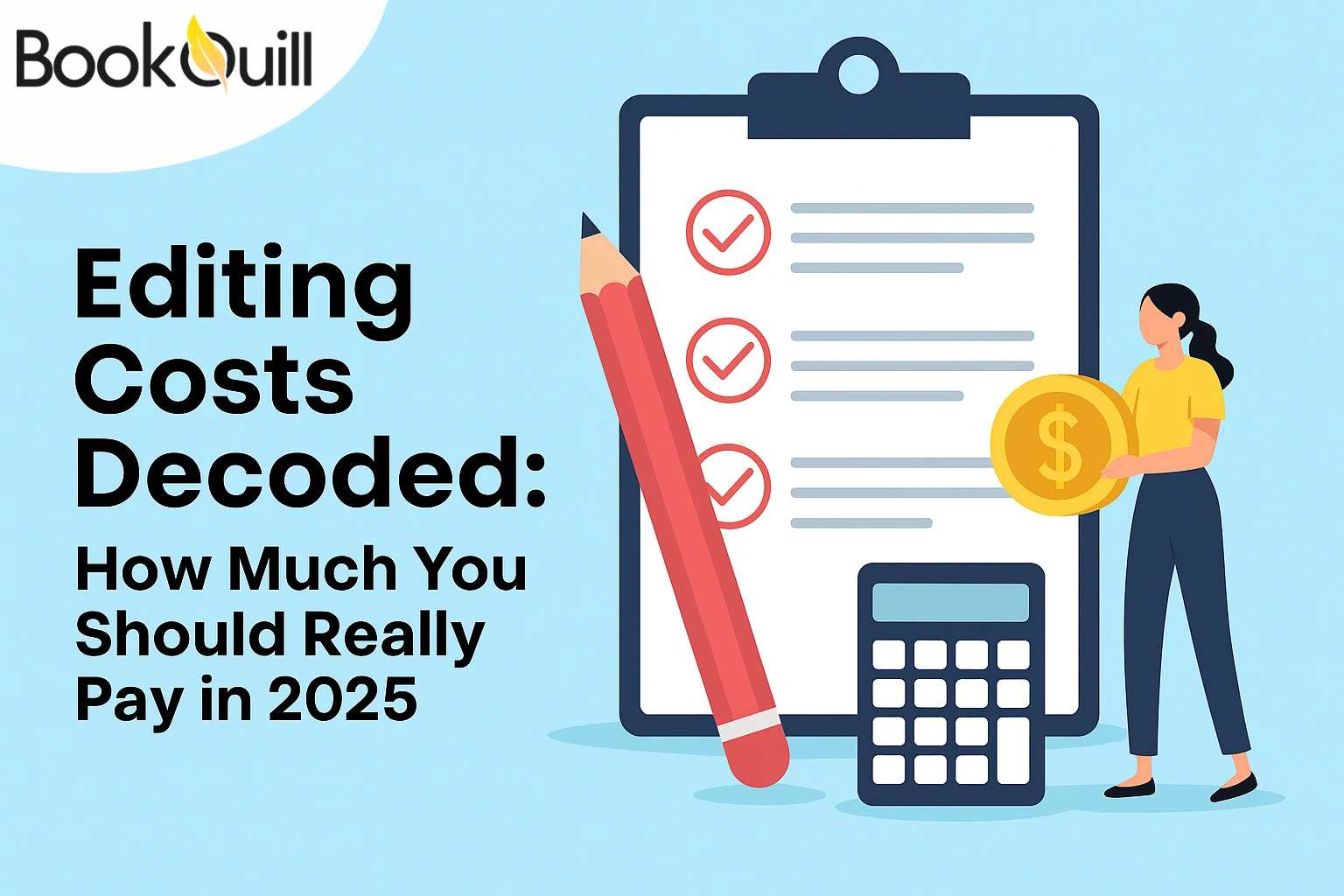Table of Contents
Explore Blogs
Trending on Ebook
Back Cover of a Book: Do’s and Don’ts

While the front cover may catch people’s attention, it’s often the back cover of a book that makes the sale. The book’s back cover provides readers information about the story and the author. If done right, it is enough to hook the reader and get them to buy your book.
Given how important a book cover is, you must invest resources and time to get it right. This is where best book design services help you! This blog lists the do’s and dont’s of designing a book cover. Keep reading to learn more!

What Goes on the Back Cover of a Book?
The back cover of a book includes a brief introduction to the author and the book itself. The look and placement of these elements may vary depending on the cover design. However, certain key elements are present in nearly every book:

The Book Blurb: The book blurb or the book description offers the reader a sneak peek of what’s to come in the book. It often includes a brief excerpt or notable quote from the book. The idea behind it is to hook the reader so they want to buy and read the book.
Testimonials and Reviews: Include quotes or words of praise from authors or known personalities on the book cover. This would help build reader confidence in your book.
About the Author: The author bio section introduces the reader to the person behind the story. It should include a few personal details, notable awards, or a reference to any previous work. The key is brevity. The author bio section is not your resume. Keep it precise and interesting.
ISBN Barcode: The back cover of the book should include the ISBN barcode, publisher information, and retail price. The ISBN or International Standard Book Number is a 13-digit unique number issued to all books published internationally. It helps in ordering, sales reporting, and storing the book.
You can get an ISBN through your publisher or register it using your country’s ISBN services.
Back of Book Cover: Do’s and Don’ts
A well-designed book back cover can be a powerful tool to persuade potential customers to buy your book. A lot of effort goes into writing a book, therefore it is important to design a cover that does justice to the story.
But how do you design a good back cover for your book? Here are some do’s and don’ts to keep in mind:
The Do’s
-
A Compelling Book Blurb
A book blurb should be concise, engaging, and capable of sparking curiosity in the reader. It is an introduction to the plot, characters, and conflict which acts as an elevator pitch rather than a synopsis or review of the book. With only 100-200 words, you must convince the reader that your book is worth reading and purchasing.
But the question is how to write a blurb for a book in a way that is interesting for the readers? Well, the key is to keep the genre and target audience in mind. Readers will likely skim through the text, so use attention-grabbing sentences that evoke emotion.
Start with an interesting question or impactful quote from the book that grabs attention. Then, introduce your characters and the main conflict of the story, while keeping the book blurb brief to avoid giving away too much information.
It’s industry practice to write book blurbs in the third person narrative across genres, although there may be differing opinions for non-fiction books and memoirs.
-
Testimonials and Reviews
Endorsements, testimonials, and reviews boosts the reader’s confidence and creates intrigue about your book. Reviews and testimonials serve as social proof which reassure potential readers that your book is worth their buying and reading.
If your book has received positive mentions in famous publications or favorable reviews from critics, consider featuring them on the back cover. You can also seek endorsements from fellow authors by sending them a copy. It is best to reach out to authors who write in the same genre.
Reviews and testimonials from renowned publications and personalities can help build credibility and encourage potential readers to pick up your book.
Want to learn more about book reviews? Read our blog on how to get book reviews on Amazon.
-
Author Bio
Don’t forget to add an ‘about the author’ or ‘author bio’ section on the book back cover. It should cover relevant credentials or talk about important experiences. You can personalize the bio and make it more relatable by adding a short personal anecdote.
Mention any other works or books you have authored that people might be interested in. Just make sure it is relevant to the audience. Consider adding a picture next to the author’s bio. Get your headshot taken professionally. Avoid selfies or pictures with other people.
An author bio would let the reader know more about the person behind the book. But, it must be done right. First time authors often go overboard with their author bios. Remember an author bio is not your resume. Keep it short, sweet, and no longer than 80 words. Let the focus be on the book blurb.
-
Use Captivating Language
Your book cover is a powerful marketing tool that can pique people’s interest in your book. So, use the right tone and writing style in your book’s back cover content.
You should write in a way that evokes emotion. It should make the readers feel excited or curious about your book. Try to create a connection with the reader by using engaging language.
The book blurb offers reader a sneak peek of your writing style, so ensure its tone aligns with your book’s overall tone and style.
-
Eye-Catching Design
Whether or not we like it, the cover is what attracts readers to a book. So invest in getting your book cover professionally designed. The design elements should complement the tone and content of your book. A professionally designed and visually appealing cover encourages potential readers to pick up your book.
The design elements should be coherent with the rest of the book and any associated marketing efforts. Consistency is key when it comes to branding and book design. The back book cover should be an extension of the front cover design. It should have the same color scheme as the front of the book.
-
Call to Action
You can add a call to action to encourage readers to perform a desirable action as a part of your marketing strategy. This could be to buy a book, visit your website, or join your monthly mailing list. A well-written call to action will be clear and enhance engagement with readers.
If you can, create a sense of urgency with your CTA. This could a limited-time offer or a special edition cover design which would incentivize immediate action. Add a CTA only if it makes sense for your book, it is not necessary for every back book cover design.
The Don’ts
-
Reveal Too Much
We all hate spoilers. So, don’t give any in your book blurb. Think of the back cover as a movie trailer for your book. It is intended to tease the audience with enough to hook them. It is not meant to reveal any major plot points. Readers often pick up a book with the hope of an engaging reading experience. By revealing too much you would be robbing the readers of the joy of discovering the plot twists in the story.
Some of the premium book design services suggest avoid giving up too much information, make it a point to keep your book blurb between 100-200 words. You can give the reader an idea of the story setting and book characters but do not reveal too much.
-
Add Too Much Information
A crowded back cover can overwhelm readers and reduce the impact of your key selling points. Instead of adding everything, focus on elements that capture and depict the essence of your book. You don’t have to add all the back cover elements we discussed above, add what seems right for your book cover design.
Use the white space and text in the right proportion to create a visually pleasing layout. This not only makes the information more digestible but adds to the overall aesthetic of your book.
-
Use Generic Language or Design
Many books are published and sold every day. How will yours stand out if you do everything someone else does? Your book’s back cover is a visual representation of its quality. People will judge your book by its cover. Because that’s all they see at first!
An unprofessional design with stock images or bad branding will give the impression that you haven’t put much thought into it. This could discourage readers from looking further into your work. Similarly, using generic language or cliched terms that are momentarily popular can tick off buyers.
-
Neglect Proofreading
Spelling errors and grammar mistakes can make your book cover seem unprofessional. It can be avoided by proofreading every section. Avoiding this step would give readers the impression that your book was carelessly written and hence is not worth their time. It’s best to get the back cover content reviewed by an editor or proofreader.
Writing tip
To avoid writing errors, review the book cover content after a short break. Sometimes, it is difficult to spot errors in the content because we have been looking at it too long. A fresh perspective can help point out any inconsistencies in the text.
-
Mislead
It may be tempting to exaggerate and oversell your book, but it is not a good idea. Misleading people to sell your book will only result in unmet expectations, disappointment, and potentially bad press for your work. Be honest with your audience about the style and substance of your book. Those interested in the genre and style will read it.
-
Ignore the Target Audience
Ignoring your audience in hopes of hopping on a trend is never a good idea. If you design a book cover that isn’t coherent with your book’s style or use language that wouldn’t appeal to the target audience, you will turn off readers from buying your book.
Stay true to your style, tone, and writing. Most importantly, do not adopt any trend or fad that alienates your audience.
Book Back Cover Examples
Now that we understand the do’s and don’ts of book covers, let’s explore some examples to see what well-designed book covers look like:
-
To Kill a Mockingbird by Harper Lee

-
1984 by George Orwell

-
All the Light We Cannot See by Anthony Doerr

-
The Midnight Library by Matt Haig

-
The Secret History by Donna Tartt

Final Word
Creating a compelling back book cover design is an art. If done right, the book’s back cover serves as a defining factor in getting a potential reader to buy your book.
The dos in this guide will help you create a visually appealing design and compelling narrative. The don’ts will advise against revealing too much or neglecting details.
Keep these book design services suggestions in mind to craft the best back cover for your book.
Frequently Asked Questions
Why is the back cover of a book important?
The back cover of a book is an important marketing tool. It offers the reader a description of what they can expect from the book in a couple hundred words. If the description is compelling enough, the reader will buy the book.
What should be on the back cover of a book?
The book’s back cover should contain a book blurb or book description, author bio, reviews and testimonials, and the ISBN bar code.
Should you put your picture on the back of your book?
You must think carefully about the target audience and branding of your book before putting your picture on the cover. If you are a subject matter expert or a known personality, putting your face on the cover would help the sales of the book. A picture could also work for personal memoirs or autobiographies. In other cases, best to avoid it.
What not to put on a book cover?
Designing a book cover requires expertise and time. Rushing the process or not allocating sufficient resources to it may cause your book cover to look unprofessional Bad typography, low-quality images, and uninteresting text are some common book cover mistakes that should be avoided.
What is the summary on the back of a book called?
The short description on the back of a book is called a ‘blurb’. It summarizes the book’s plot, theme, and characters, and is written to convince the reader to buy and read the book.




